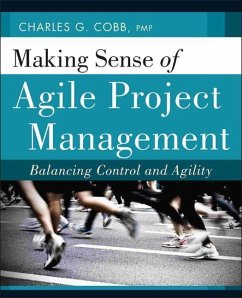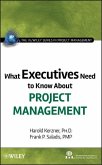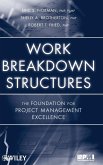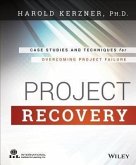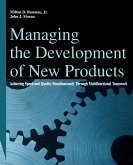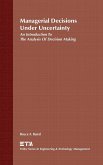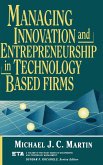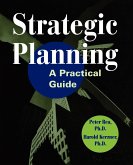Charles G Cobb
Making Sense of Agile Project Management
Charles G Cobb
Making Sense of Agile Project Management
- Broschiertes Buch
- Merkliste
- Auf die Merkliste
- Bewerten Bewerten
- Teilen
- Produkt teilen
- Produkterinnerung
- Produkterinnerung
The book is intended to provide a much deeper understanding of agile principles, methodologies, and practices to enable project managers to develop a more agile approach and understand how to blend and tailor agile and traditional principles, methodologies, and practices to create an appropriate balance of control and agility to fit a business environment as well as the risks and complexities of any individual project. The book will also provide business managers and leaders an understanding of how to fit agile methodologies into an overall business strategy that provides the right balance of control and agility for their business.…mehr
Andere Kunden interessierten sich auch für
![What Executives Need to Know about Project Management What Executives Need to Know about Project Management]() International Institute for LearningWhat Executives Need to Know about Project Management42,99 €
International Institute for LearningWhat Executives Need to Know about Project Management42,99 €![Work Breakdown Structures Work Breakdown Structures]() Eric S NormanWork Breakdown Structures89,99 €
Eric S NormanWork Breakdown Structures89,99 €![Project Recovery Project Recovery]() Harold KerznerProject Recovery76,99 €
Harold KerznerProject Recovery76,99 €![Managing the Development of New Products Managing the Development of New Products]() Milton D RosenauManaging the Development of New Products114,99 €
Milton D RosenauManaging the Development of New Products114,99 €![Managerial Decisions Under Uncertainty Managerial Decisions Under Uncertainty]() Bruce F BairdManagerial Decisions Under Uncertainty184,99 €
Bruce F BairdManagerial Decisions Under Uncertainty184,99 €![Managing Innovation and Entrepreneurship in Technology-Based Firms Managing Innovation and Entrepreneurship in Technology-Based Firms]() Michael J C MartinManaging Innovation and Entrepreneurship in Technology-Based Firms165,99 €
Michael J C MartinManaging Innovation and Entrepreneurship in Technology-Based Firms165,99 €![Strategic Planning Strategic Planning]() Peter J ReaStrategic Planning129,99 €
Peter J ReaStrategic Planning129,99 €-
-
-
The book is intended to provide a much deeper understanding of agile principles, methodologies, and practices to enable project managers to develop a more agile approach and understand how to blend and tailor agile and traditional principles, methodologies, and practices to create an appropriate balance of control and agility to fit a business environment as well as the risks and complexities of any individual project. The book will also provide business managers and leaders an understanding of how to fit agile methodologies into an overall business strategy that provides the right balance of control and agility for their business.
Produktdetails
- Produktdetails
- Verlag: John Wiley & Sons / Wiley
- Seitenzahl: 272
- Erscheinungstermin: 8. März 2011
- Englisch
- Abmessung: 237mm x 192mm x 15mm
- Gewicht: 471g
- ISBN-13: 9780470943366
- ISBN-10: 047094336X
- Artikelnr.: 33391775
- Herstellerkennzeichnung
- Libri GmbH
- Europaallee 1
- 36244 Bad Hersfeld
- gpsr@libri.de
- Verlag: John Wiley & Sons / Wiley
- Seitenzahl: 272
- Erscheinungstermin: 8. März 2011
- Englisch
- Abmessung: 237mm x 192mm x 15mm
- Gewicht: 471g
- ISBN-13: 9780470943366
- ISBN-10: 047094336X
- Artikelnr.: 33391775
- Herstellerkennzeichnung
- Libri GmbH
- Europaallee 1
- 36244 Bad Hersfeld
- gpsr@libri.de
CHARLES G. (CHUCK) COBB, PMP, is President of Breakthrough Solutions, Inc., of Medfield, Massachusetts. He is a senior-level project/program manager with a broad and deep background in business systems analysis and software development. He has worked with many companies in different application environments using numerous project management methodologies-both agile and not-so-agile-for more than twenty years.
Preface ix
Who Should Read This Book? ix
Brief Overview of the Book x
Why I Wrote This Book xii
How to Use This Book xiv
Part I xiv
Part II xv
Part III xvi
Acknowledgments xvii
Part I Overview
1 Introduction 3
Meaning of the Word "Agile" 3
Meaning of the Word "Waterfall" 5
Polarization of Agile and Traditional Waterfall Approaches 7
The Program du Jour Effect 9
Impact on Project Management 10
Common Agile Misconceptions 14
The Pizza Box Methodology 14
All-or-Nothing Thinking 15
Traditional Development Approaches Are Dead 15
Just Do It Faster 16
Becoming Agile Only Impacts the Development Organization 16
Agile Is Just a Development Methodology 17
What Agile Doesn't Tell You 18
2 Agile Values, Principles, and Practices 21
Lean Software Development Principles 21
Lean Principles 22
Interrelationship of Lean and Agile 36
Agile History and Overview 38
Agile Perceptions and Reality 44
General Agile Practices 47
Organizational Practices 48
Planning Practices 49
Requirements Definition Practices 51
Summary of Agile Techniques and Practices 54
3 Becoming More Agile 57
Agile Benefits and Tradeoffs 57
Focus on Successful Business Outcomes 57
Customer Satisfaction and Competitive Advantage 60
Organizational Effectiveness, Cross-Functional Synergy, and Employee Morale
60
Higher Productivity and Lower Costs 60
Potential for Higher Quality 62
Obstacles to Becoming Agile 62
Corporate Culture 63
Organizational Commitment 66
Risk and Regulatory Environment 66
Developing a More Agile Approach 67
Developing an Agile or Lean Mindset 67
Hybrid Approaches 68
4 Case Studies 71
Sapient 73
Unique Challenges 73
Process Methodology Selection and Design 74
Methodology Summary 77
Methodology Description 78
5 Part I Summary and Action Plan 85
Overall Summary 85
Developing an Action Plan for Your Business 88
Planning Questions 88
Alternative Approaches 91
How Do You Get There? 93
Part II Overview
6 Agile Project Management 101
Agile Project Management Roles 101
Comparison of Traditional and Agile Project Management Roles 103
Agile Business Analyst Role 106
Agile Project Management Approach 107
Project Management Mindset 107
Project Management Skills 111
Agile Project Management Practices 112
Agile Project Management Principles 113
Agile Project Management Techniques 117
Agile Project Management Models 119
Agile and A Guide to Project Management Body of Knowledge (PMBOK® Guide)
124
Merging PMBOK® Thinking and Agile Thinking 130
7 Fundamental Principles behind SDLC Models 131
General Software Development Life Cycle (SDLC) Considerations 132
Flexibility versus Rigidity 133
Relationship of Training and Process Design 135
Reliable versus Repeatable Processes 136
Interrelationship of Life-Cycle Model Selection Factors 138
Requirements Definition and Management Approach 138
Business Process Considerations 141
Requirements Complexity Considerations 142
Testing Considerations 142
Supportability Considerations 144
Prioritization of Requirements 145
Risk Management, Uncertainty, and Planning Approach 148
Risk Management Considerations 148
Management of Uncertainty Considerations 151
The Role of Planning 154
The Role of Leadership and Training 156
Leadership 156
Training 158
The Role of Documentation 160
8 Software Development Life Cycles 163
Types of Software Development Life Cycles 164
Traditional Plan-Driven Life-Cycle Model 168
Incremental Life-Cycle Model 173
Iterative Plan-Driven Life-Cycle Model 174
Iterative Emergent Life-Cycle Model 176
Adaptive Life-Cycle Model 178
Summary of SDLC Guidelines 180
General Considerations 180
Requirements Management Considerations 181
Risk Management Considerations 181
Project Scope and Complexity Considerations 182
Other Considerations 182
Selecting a Software Development Life Cycle 182
Comparison of Approaches 182
Life-Cycle Model Selection Examples 184
9 Part II Summary and Action Plan 191
Summary of Impact on Project Managers and PMI® 191
Developing an Action Plan for Project Managers 193
Incremental Improvements 193
Designing and Implementing Hybrid Approaches 194
Implementing Pure Agile Project Management Approaches 194
Helping Companies Move in the Right Direction 195
Part III Appendices
Appendix A Overview of Agile Development Practices 199
Extreme Programming 199
Feature-Driven Development 202
Test-Driven Development 205
Pair Programming 207
Code Refactoring 208
Continuous Integration 209
Appendix B Overview of Agile Project Delivery Frameworks 211
Scrum 211
Dynamic Systems Development Model (DSDM) 215
Agile Modeling 219
Agile Unified Process 221
Lean Software Development 224
Additional Reading 228
Glossary of Terms 228
Index 235
Who Should Read This Book? ix
Brief Overview of the Book x
Why I Wrote This Book xii
How to Use This Book xiv
Part I xiv
Part II xv
Part III xvi
Acknowledgments xvii
Part I Overview
1 Introduction 3
Meaning of the Word "Agile" 3
Meaning of the Word "Waterfall" 5
Polarization of Agile and Traditional Waterfall Approaches 7
The Program du Jour Effect 9
Impact on Project Management 10
Common Agile Misconceptions 14
The Pizza Box Methodology 14
All-or-Nothing Thinking 15
Traditional Development Approaches Are Dead 15
Just Do It Faster 16
Becoming Agile Only Impacts the Development Organization 16
Agile Is Just a Development Methodology 17
What Agile Doesn't Tell You 18
2 Agile Values, Principles, and Practices 21
Lean Software Development Principles 21
Lean Principles 22
Interrelationship of Lean and Agile 36
Agile History and Overview 38
Agile Perceptions and Reality 44
General Agile Practices 47
Organizational Practices 48
Planning Practices 49
Requirements Definition Practices 51
Summary of Agile Techniques and Practices 54
3 Becoming More Agile 57
Agile Benefits and Tradeoffs 57
Focus on Successful Business Outcomes 57
Customer Satisfaction and Competitive Advantage 60
Organizational Effectiveness, Cross-Functional Synergy, and Employee Morale
60
Higher Productivity and Lower Costs 60
Potential for Higher Quality 62
Obstacles to Becoming Agile 62
Corporate Culture 63
Organizational Commitment 66
Risk and Regulatory Environment 66
Developing a More Agile Approach 67
Developing an Agile or Lean Mindset 67
Hybrid Approaches 68
4 Case Studies 71
Sapient 73
Unique Challenges 73
Process Methodology Selection and Design 74
Methodology Summary 77
Methodology Description 78
5 Part I Summary and Action Plan 85
Overall Summary 85
Developing an Action Plan for Your Business 88
Planning Questions 88
Alternative Approaches 91
How Do You Get There? 93
Part II Overview
6 Agile Project Management 101
Agile Project Management Roles 101
Comparison of Traditional and Agile Project Management Roles 103
Agile Business Analyst Role 106
Agile Project Management Approach 107
Project Management Mindset 107
Project Management Skills 111
Agile Project Management Practices 112
Agile Project Management Principles 113
Agile Project Management Techniques 117
Agile Project Management Models 119
Agile and A Guide to Project Management Body of Knowledge (PMBOK® Guide)
124
Merging PMBOK® Thinking and Agile Thinking 130
7 Fundamental Principles behind SDLC Models 131
General Software Development Life Cycle (SDLC) Considerations 132
Flexibility versus Rigidity 133
Relationship of Training and Process Design 135
Reliable versus Repeatable Processes 136
Interrelationship of Life-Cycle Model Selection Factors 138
Requirements Definition and Management Approach 138
Business Process Considerations 141
Requirements Complexity Considerations 142
Testing Considerations 142
Supportability Considerations 144
Prioritization of Requirements 145
Risk Management, Uncertainty, and Planning Approach 148
Risk Management Considerations 148
Management of Uncertainty Considerations 151
The Role of Planning 154
The Role of Leadership and Training 156
Leadership 156
Training 158
The Role of Documentation 160
8 Software Development Life Cycles 163
Types of Software Development Life Cycles 164
Traditional Plan-Driven Life-Cycle Model 168
Incremental Life-Cycle Model 173
Iterative Plan-Driven Life-Cycle Model 174
Iterative Emergent Life-Cycle Model 176
Adaptive Life-Cycle Model 178
Summary of SDLC Guidelines 180
General Considerations 180
Requirements Management Considerations 181
Risk Management Considerations 181
Project Scope and Complexity Considerations 182
Other Considerations 182
Selecting a Software Development Life Cycle 182
Comparison of Approaches 182
Life-Cycle Model Selection Examples 184
9 Part II Summary and Action Plan 191
Summary of Impact on Project Managers and PMI® 191
Developing an Action Plan for Project Managers 193
Incremental Improvements 193
Designing and Implementing Hybrid Approaches 194
Implementing Pure Agile Project Management Approaches 194
Helping Companies Move in the Right Direction 195
Part III Appendices
Appendix A Overview of Agile Development Practices 199
Extreme Programming 199
Feature-Driven Development 202
Test-Driven Development 205
Pair Programming 207
Code Refactoring 208
Continuous Integration 209
Appendix B Overview of Agile Project Delivery Frameworks 211
Scrum 211
Dynamic Systems Development Model (DSDM) 215
Agile Modeling 219
Agile Unified Process 221
Lean Software Development 224
Additional Reading 228
Glossary of Terms 228
Index 235
Preface ix
Who Should Read This Book? ix
Brief Overview of the Book x
Why I Wrote This Book xii
How to Use This Book xiv
Part I xiv
Part II xv
Part III xvi
Acknowledgments xvii
Part I Overview
1 Introduction 3
Meaning of the Word "Agile" 3
Meaning of the Word "Waterfall" 5
Polarization of Agile and Traditional Waterfall Approaches 7
The Program du Jour Effect 9
Impact on Project Management 10
Common Agile Misconceptions 14
The Pizza Box Methodology 14
All-or-Nothing Thinking 15
Traditional Development Approaches Are Dead 15
Just Do It Faster 16
Becoming Agile Only Impacts the Development Organization 16
Agile Is Just a Development Methodology 17
What Agile Doesn't Tell You 18
2 Agile Values, Principles, and Practices 21
Lean Software Development Principles 21
Lean Principles 22
Interrelationship of Lean and Agile 36
Agile History and Overview 38
Agile Perceptions and Reality 44
General Agile Practices 47
Organizational Practices 48
Planning Practices 49
Requirements Definition Practices 51
Summary of Agile Techniques and Practices 54
3 Becoming More Agile 57
Agile Benefits and Tradeoffs 57
Focus on Successful Business Outcomes 57
Customer Satisfaction and Competitive Advantage 60
Organizational Effectiveness, Cross-Functional Synergy, and Employee Morale
60
Higher Productivity and Lower Costs 60
Potential for Higher Quality 62
Obstacles to Becoming Agile 62
Corporate Culture 63
Organizational Commitment 66
Risk and Regulatory Environment 66
Developing a More Agile Approach 67
Developing an Agile or Lean Mindset 67
Hybrid Approaches 68
4 Case Studies 71
Sapient 73
Unique Challenges 73
Process Methodology Selection and Design 74
Methodology Summary 77
Methodology Description 78
5 Part I Summary and Action Plan 85
Overall Summary 85
Developing an Action Plan for Your Business 88
Planning Questions 88
Alternative Approaches 91
How Do You Get There? 93
Part II Overview
6 Agile Project Management 101
Agile Project Management Roles 101
Comparison of Traditional and Agile Project Management Roles 103
Agile Business Analyst Role 106
Agile Project Management Approach 107
Project Management Mindset 107
Project Management Skills 111
Agile Project Management Practices 112
Agile Project Management Principles 113
Agile Project Management Techniques 117
Agile Project Management Models 119
Agile and A Guide to Project Management Body of Knowledge (PMBOK® Guide)
124
Merging PMBOK® Thinking and Agile Thinking 130
7 Fundamental Principles behind SDLC Models 131
General Software Development Life Cycle (SDLC) Considerations 132
Flexibility versus Rigidity 133
Relationship of Training and Process Design 135
Reliable versus Repeatable Processes 136
Interrelationship of Life-Cycle Model Selection Factors 138
Requirements Definition and Management Approach 138
Business Process Considerations 141
Requirements Complexity Considerations 142
Testing Considerations 142
Supportability Considerations 144
Prioritization of Requirements 145
Risk Management, Uncertainty, and Planning Approach 148
Risk Management Considerations 148
Management of Uncertainty Considerations 151
The Role of Planning 154
The Role of Leadership and Training 156
Leadership 156
Training 158
The Role of Documentation 160
8 Software Development Life Cycles 163
Types of Software Development Life Cycles 164
Traditional Plan-Driven Life-Cycle Model 168
Incremental Life-Cycle Model 173
Iterative Plan-Driven Life-Cycle Model 174
Iterative Emergent Life-Cycle Model 176
Adaptive Life-Cycle Model 178
Summary of SDLC Guidelines 180
General Considerations 180
Requirements Management Considerations 181
Risk Management Considerations 181
Project Scope and Complexity Considerations 182
Other Considerations 182
Selecting a Software Development Life Cycle 182
Comparison of Approaches 182
Life-Cycle Model Selection Examples 184
9 Part II Summary and Action Plan 191
Summary of Impact on Project Managers and PMI® 191
Developing an Action Plan for Project Managers 193
Incremental Improvements 193
Designing and Implementing Hybrid Approaches 194
Implementing Pure Agile Project Management Approaches 194
Helping Companies Move in the Right Direction 195
Part III Appendices
Appendix A Overview of Agile Development Practices 199
Extreme Programming 199
Feature-Driven Development 202
Test-Driven Development 205
Pair Programming 207
Code Refactoring 208
Continuous Integration 209
Appendix B Overview of Agile Project Delivery Frameworks 211
Scrum 211
Dynamic Systems Development Model (DSDM) 215
Agile Modeling 219
Agile Unified Process 221
Lean Software Development 224
Additional Reading 228
Glossary of Terms 228
Index 235
Who Should Read This Book? ix
Brief Overview of the Book x
Why I Wrote This Book xii
How to Use This Book xiv
Part I xiv
Part II xv
Part III xvi
Acknowledgments xvii
Part I Overview
1 Introduction 3
Meaning of the Word "Agile" 3
Meaning of the Word "Waterfall" 5
Polarization of Agile and Traditional Waterfall Approaches 7
The Program du Jour Effect 9
Impact on Project Management 10
Common Agile Misconceptions 14
The Pizza Box Methodology 14
All-or-Nothing Thinking 15
Traditional Development Approaches Are Dead 15
Just Do It Faster 16
Becoming Agile Only Impacts the Development Organization 16
Agile Is Just a Development Methodology 17
What Agile Doesn't Tell You 18
2 Agile Values, Principles, and Practices 21
Lean Software Development Principles 21
Lean Principles 22
Interrelationship of Lean and Agile 36
Agile History and Overview 38
Agile Perceptions and Reality 44
General Agile Practices 47
Organizational Practices 48
Planning Practices 49
Requirements Definition Practices 51
Summary of Agile Techniques and Practices 54
3 Becoming More Agile 57
Agile Benefits and Tradeoffs 57
Focus on Successful Business Outcomes 57
Customer Satisfaction and Competitive Advantage 60
Organizational Effectiveness, Cross-Functional Synergy, and Employee Morale
60
Higher Productivity and Lower Costs 60
Potential for Higher Quality 62
Obstacles to Becoming Agile 62
Corporate Culture 63
Organizational Commitment 66
Risk and Regulatory Environment 66
Developing a More Agile Approach 67
Developing an Agile or Lean Mindset 67
Hybrid Approaches 68
4 Case Studies 71
Sapient 73
Unique Challenges 73
Process Methodology Selection and Design 74
Methodology Summary 77
Methodology Description 78
5 Part I Summary and Action Plan 85
Overall Summary 85
Developing an Action Plan for Your Business 88
Planning Questions 88
Alternative Approaches 91
How Do You Get There? 93
Part II Overview
6 Agile Project Management 101
Agile Project Management Roles 101
Comparison of Traditional and Agile Project Management Roles 103
Agile Business Analyst Role 106
Agile Project Management Approach 107
Project Management Mindset 107
Project Management Skills 111
Agile Project Management Practices 112
Agile Project Management Principles 113
Agile Project Management Techniques 117
Agile Project Management Models 119
Agile and A Guide to Project Management Body of Knowledge (PMBOK® Guide)
124
Merging PMBOK® Thinking and Agile Thinking 130
7 Fundamental Principles behind SDLC Models 131
General Software Development Life Cycle (SDLC) Considerations 132
Flexibility versus Rigidity 133
Relationship of Training and Process Design 135
Reliable versus Repeatable Processes 136
Interrelationship of Life-Cycle Model Selection Factors 138
Requirements Definition and Management Approach 138
Business Process Considerations 141
Requirements Complexity Considerations 142
Testing Considerations 142
Supportability Considerations 144
Prioritization of Requirements 145
Risk Management, Uncertainty, and Planning Approach 148
Risk Management Considerations 148
Management of Uncertainty Considerations 151
The Role of Planning 154
The Role of Leadership and Training 156
Leadership 156
Training 158
The Role of Documentation 160
8 Software Development Life Cycles 163
Types of Software Development Life Cycles 164
Traditional Plan-Driven Life-Cycle Model 168
Incremental Life-Cycle Model 173
Iterative Plan-Driven Life-Cycle Model 174
Iterative Emergent Life-Cycle Model 176
Adaptive Life-Cycle Model 178
Summary of SDLC Guidelines 180
General Considerations 180
Requirements Management Considerations 181
Risk Management Considerations 181
Project Scope and Complexity Considerations 182
Other Considerations 182
Selecting a Software Development Life Cycle 182
Comparison of Approaches 182
Life-Cycle Model Selection Examples 184
9 Part II Summary and Action Plan 191
Summary of Impact on Project Managers and PMI® 191
Developing an Action Plan for Project Managers 193
Incremental Improvements 193
Designing and Implementing Hybrid Approaches 194
Implementing Pure Agile Project Management Approaches 194
Helping Companies Move in the Right Direction 195
Part III Appendices
Appendix A Overview of Agile Development Practices 199
Extreme Programming 199
Feature-Driven Development 202
Test-Driven Development 205
Pair Programming 207
Code Refactoring 208
Continuous Integration 209
Appendix B Overview of Agile Project Delivery Frameworks 211
Scrum 211
Dynamic Systems Development Model (DSDM) 215
Agile Modeling 219
Agile Unified Process 221
Lean Software Development 224
Additional Reading 228
Glossary of Terms 228
Index 235

